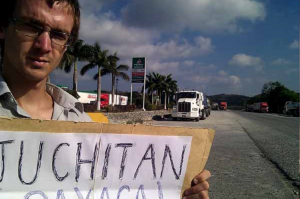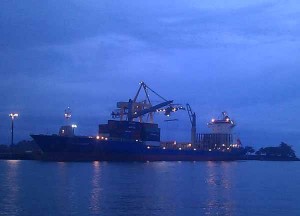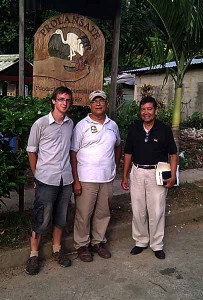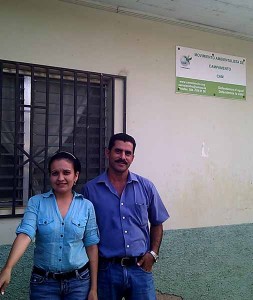I hope that my blog, or at least some parts of it, has been interesting to those who’ve read it! Travelling as a sponsored journey for ENCA – with an overall purpose of avoiding planes and with this blog to record the most interesting parts – has for me made the whole year a lot more interesting, and given it a sense of purpose. In particular, the blog has helped me notice and think in more detail about some of the best parts of the trip, and I feel like it’s been a real opportunity not just to travel but to learn more about the people and places I’ve visited. The most vivid memories have been from hitch-hiking and couchsurfing, travelling by cargo ship, working with the clinic in Nicaragua, and visiting all the ENCA partners to see their struggles around the environment and justice in Central America.
Hitch-hiking and Couchsurfing

Hitching in Mexico
Across Europe and Turkey and much of Mexico, I hitch-hiked to get from A to B, and used Couchsurfing to find places to stay wherever I ended up. Couchsurfing is a free website (here) or online community of people who advertise the free bed space in their homes, for people to potentially stay over on their travels. Both involve throwing yourself on chance and the kindness of complete strangers, and for this reason both were incredible experiences for me. To be able to get hundreds of miles, across whole countries and continents, with no formal travel companies was amazing. Just the rush of gratefulness every single time someone picks you up – chooses to take the risk and help someone they’ve no knowledge of at all – opens you to the most stunning realisation that the world is full of good people.
Then, you arrive in a new place – you might have heard of it, or maybe it’s lost in the back end of no where you’d ever imagined you’d visit – and, through Couchsurfing, meet another stranger who lets you sleep in their home for free! But more than that, with Couchsurfing you meet someone looking to welcome you as a new friend – and prepared to be an amazing local guide to teach a bit about the place you’ve found yourself in. In terms of life-changing experiences, I think these simple methods of travel top anything else I have done this year – and they’re available to anyone even in their own country! You can read more about my original experiences and thoughts hitch-hiking and couchsurfing on my first article, a later one about Turkey and another about my return towards Le Havre.
Cargo Ship Travel

The HS Schubert, the ship I returned to Europe on – a 14 day journey from Costa Rica
Coming back to Europe, I have just completed my second journey as a passenger on a cargo ship. Earlier articles cover the experience on the ship on the way out, and the all important relative carbon-emissions caused by cargo ship travel as opposed to flying (the fundamental reasons why I chose to do the whole year’s travel without planes). My return trip was 14 days, a little shorter than the outward journey, but even more enjoyable. It turns out there are some big differences between ships – although the return vessel, the HS Schubert, was similar to the BF Ipanema on the way out, the officers and crew on the Schubert were a bit more relaxed and it felt a bit more like a holiday experience.
Cargo ship travel certainly wouldn’t be for everyone – before getting on the ship back in November I was terrified that I wouldn’t be able to cope psychologically with being isolated out in the middle of the ocean – literally hundreds of miles from land or a doctor. And I was also worried about all that time with no-one but a busy crew and myself to keep myself occupied. But within a day or two on the BF Ipanema, and for the whole of my return on the Schubert, the fear of isolation had given way to sheer awe at the huge, changing beauty of the ocean. On one occasion on the return trip I finally caught a shoal of dolphin playing around the ship, and the amazing uniqueness of experiences like that make the journey worth it. But even when only waves break the surface of the empty ocean, you can’t help but get lost in its simple beauty and inconceivable vastness – this endless surface covers our planet and reminds you just how big Earth is, and how small and reliant we are on it.
Most important on a 2 week voyage though is to have something to do, and so I had armed myself with a computer full of downloaded books and films for both journeys. Between reading, staring at the sea, taking the sun (on the Caribbean end of the journeys) and organising my thoughts from my travels, I found it extremely beneficial to have this empty time, remote from daily living, to fill with whatever thoughts I wanted.
The Clinica Xochil

Berta, coordinator of the Clinica Xochil, with some of the supplies they received from Wisconsin Nicaragua Partnership
Having a chance to return to the clinic for 2 weeks at the end of my time in Central America was, it turned out, an essential part of my volunteering, that made the whole experience much more rewarding. When I arrived, the clinic was just in the process of moving site, to a much better building on the other side of El Viejo. This had been a priority I identified with the clinic’s doctors back in January, so it was great to see this finally happen. Moreover, I found out on my return that some of the donor-relations I had been trying to build for the clinic had finally been paying off – a US organisation called Wisconsin Nicaragua Partnership had sent a huge donation of medical supplies and equipment, and they were to send a second one before I left. Then, we received a visitor from Norwich-El Viejo link, a UK based charity I had contacted in February, and they made a cash donation too.
Seeing all these changes, after the ground-work I had helped to lay previously, was extremely gratifying. In addition, in these last 2 week I was able to use the connections and Spanish skills I had established previous to arrange a solid period of shadowing with the doctors in the government hospitals of the area. This got me much closer to medical work than I had been able to get the clinic, and rounded off the experiences I was looking for to help me at medical school back in the UK. The entire period spent at the clinic has given me the best foundation in what medicine means in Central America that I could have hoped for.
Getting Below the Surface of Central America with ENCA

Me with Dennis Sierra and José of Fundación PROLANSATE, Honduras – one of the many groups I met that showed me their work
The opportunities that ENCA’s connections have given me while travelling through Central America – and even up into Mexico – have been incredible, and made a huge difference to the depth of experience I was able to have travelling. I’ve been involved in ENCA since 2007 and already had some knowledge of the environmental and social problems of the region, but I learnt a huge amount this year about just how interconnected the issues in Central America are. Environmental issues tied to health problems abound across the region – chronic respiratory problems from firewood smoke, water contamination from ineffective latrines, deforestation leading to lack of clean water and cancers and birth-defects from agrochemicals, to name just a few. Behind all these problems lies the socio-economic disadvantage of the countries and marginalised people within them. And behind this run the channels of corruption and exploitation that maintain it – that concentrate what wealth there is in the country with tiny minorities with support from international trade and local politicians, and leave little extra for meaningful development for the impoverished majority. Countries where the environment is exploited by big-businesses without any regard for the locals who rely on it for their survival, just as the scarcity of jobs allows big business to exploit cheap labour with bare safety regulations.
But what really amazed me on this trip was how these common threads unite such a sheer diversity of different people and social movements there. Each of the organisations I visited showed me a completely different way of life, and each had their own struggles and ways of fighting – from the CMO in Nicaragua helping women organise small businesses to help themselves (see my article, p4-5 of ENCA newsletter 58 – May 2013), to the demonstration plots of MOPAWI and IPES bringing innovative agriculture to support marginalised farmers in Honduras and El Salvador. From, in Honduras, the dangerous social protest of COPINH and the international legal challenges of OFRANEH, all the way up to the outright rebellion and creation of completely autonomous spaces of the Zapatistas of Mexico (who are still – for their sheer determination of will not to be victims any more – the group that inspired me the most).
It is worth bearing in mind that ENCA is a very open organisation – anyone interested in the region is welcome to contact us and even join us at our meetings every 4 months in London. ENCA has a myriad of connections and is always looking to help foster links in the UK and promote Central American voluntary work. Anyone considering a period volunteering abroad, please do contact us if you want any more info about genuinely worthwhile opportunities where you can be part of the incredible and valuable struggles in the region.

The Campamento Environmental Movement – the director Juan (right) gave me a tour of the local area demonstrating the creeping deforestation they are fighting
For everyone else in the UK (and internationally), thank you for reading the blog, and if you are not already a member of ENCA, I’d recommend signing up so that you can stay up to date with movement in Central America – not an easy place to get news about in Europe – when we send out our newsletters 3 times a year. The money raised from your sponsorship of my year has been amazing, but I’ve also seen just how much more need there is in the region, and ENCA really needs more regular donors to continue supporting small and valuable projects over there. A small part of our money is spent on printing our newsletter and occasional other costs in the UK, but all the rest goes direct to projects entirely run by the kinds of organisations I’ve written about – ENCA has absolutely no paid staff or office costs to take your money.
Regardless, I hope your interest has been raised a bit in this fascinating area.
